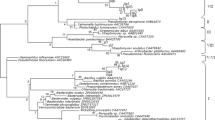Abstract
Bacteria able to convert oleic acid to 10-hydroxystearic acid were isolated from the ovine rumen. The solid hydroxy fatty acid produced from bacterial fermentations containing oleic acid was recovered by filtration, extraction into ether and crystallisation. The identity of the product was confirmed by HPLC and gas chromatography/mass spectrometry. One 10-hydroxystearic-acid-producing bacterial group was represented by two strains of an anaerobic gram-negative curved rod with tufts of flagella on the concave surface of the cell. The morphology and other characteristics enabled the strains to be tentatively identified as Selenomonas ruminantium. Another bacterium capable of the same transformation, represented by two strains of a facultatively anaerobic gram positive chain-forming coccus, was identified as Enterococcus faecalis. Since unsaturated fatty acids entering the rumen are normally hydrogenated, hydration of oleic acid represents an alternative fate of unknown significance in vivo.
Similar content being viewed by others
References
Bridge PD, Sneath PHA (1983) Numerical taxonomy of Streptococcus. J Gen Microbiol 129:565–597
Bryant MP (1984) Selenomonas. In: Krieg NR, Holt JG (eds) Bergey's manual of systematic bacteriology, vol 1. Williams & Wilkins, Baltimore, pp 650–653
Christie WW (1987) The analysis of fatty acids. In: High-performance liquid chromatography and lipids. Pergmon, Oxford, pp 133–168
Davis EN, Wallen LL, Goodwin JC, Rohwedder WK (1969) Microbial hydration of cis-9-alkenoic acids. Lipids 4:356–362
Devriese LA, Pot B, Collins MD (1993) Phenotypic characterisation of the genus Enterococcus and differentiation of phylogenetically distinct enterococcal species and speices groups. J Appl Bacteriol 75:399–408
Harborth PB, Hanert HH (1982) Isolation of Selenomonas ruminatium from an aquatic ecosystem. Arch Microbiol 132:135–140
Hardie JM (1984) Streptococcus In: Krieg NR, Holt JG (eds) Bergey's manual of systematic bacteriology, vol 2. William & Wilkins, Baltimore, pp 1043–1047
Harfoot CG, Hazlewood GP (1988) Lipid metabolism in the rumen. In: Hobson PN (ed) The rumen microbial ecosystem. Elsevier, London, pp 323–342
Hazlewood GP, Kemp P, Lander D, Dawson RMC (1976) C18 unsaturated fatty acid hydrogenation patterns of some rumen bacteria and their ability to hydrolyse exogenous phospholipid. Br J Nutr 35:293–297
Jordi HC (1978) Separation of long chain and short chain fatty acids as naphthacyl and substituted phenacyl esters by high performance liquid chromatography. J Liq Chromatogr 1:215–230
Kemp P, White RW, Lander DJ (1975) The hydrogenation of unsaturated fatty acids by five bacterial isolates from the sheep rumen, including a new species. J Gen Microbiol 90:100–114
Latham MJ, Sharpe ME, Weiss N (1979) Anaerobic cocci from the bovine alimentary tract, the amino acids of their cell wall peptidoglycans and those of various species of anaerobic Streptococcus. J Appl Bacteriol 47:209–221
Mundt JO (1984) Enterococci In: Krieg NR, Holt JG (eds) Bergey's manual of systematic bacteriology, vol 2. Williams & Wilkins, Baltimore, pp 1063–1066
Payne E (1974) Hydrogenation of unsaturated fatty acids by ruminal fluid in vitro. Proc NZ Anim Prod 34:65
Scheifinger CC, Latham MJ, Wolin MJ (1975) Relationship of lactate dehydrogenase specificity and growth rate to lactate metabolism by Selenomonas ruminantium. Appl Microbiol 30:916–921
Schleifer KH, Kilpper-Bälz R (1984) Transfer of Streptococcus faecalis and Streptococcus faecium to the genus Enterococcus nom. rev. as Enterococcus faecalis comb. nov. and Enterococcus faecium comb. nov. Int J System Bacteriol 34:31–34
Thomas PJ (1972) Identification of some enteric bacteria which convert oleic acid to hydroxystearic acid in vitro. Gastroenterology 62:430–435
Van Nevel CJ, Demeyer DI (1988) Manipulation of rumen fermentation. In: Hobson PN (ed) The rumen microbial ecosystem. Elsevier, London, pp 387–443
Wallen LL, Benedict RG, Jackson RW (1962) The microbial production of 10-hydroxystearic acid from oleic acid. Arch Biochem Biophys 99:249–253
Weast RC (1975) CRC Handbook of chemistry and physics. CRC, Cleveland
Wood R, Lee T (1983) High-performance liquid chromatography of fatty acids: quantitative analysis of saturated, monoenoic, polyenoic and geometrical isomers. J Chromatogr 254:237–246
Author information
Authors and Affiliations
Rights and permissions
About this article
Cite this article
Hudson, J.A., MacKenzie, C.A.M. & Joblin, K.N. Conversion of oleic acid to 10-hydroxystearic acid by two species of ruminal bacteria. Appl Microbiol Biotechnol 44, 1–6 (1995). https://doi.org/10.1007/BF00164472
Received:
Revised:
Accepted:
Issue Date:
DOI: https://doi.org/10.1007/BF00164472




